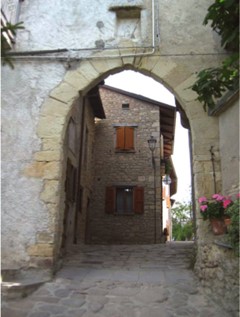The lower village of the Castle of Montecuccolo
The traces of the Montecuccoli family are still very evident even in the village spreading out at the foot of the imposing fortress. Between the 14th and 15th centuries, the Montecuccoli took exclusive possession of the highest part of the mountain where the fortress sat, and surrounded it with the third set of walls, evicting the families living there who were forced to move downhill.
This was how the village developed at the foot of the fortress, the inhabited nucleus defined in documents as the “lower village”. In line with a fairly widespread typology, the village houses arranged around the piazza onto which face the church, the bourgeois dwellings and the imposing residence of the Lord, actually form a fourth defensive wall with their dense fabric, the outermost one encircling the whole castle.
Access to the village was only possible through two gates: The first, called Bonvicina but later demolished, opened northwards towards the roads and paths that lead to Pavullo; the second, which still exists, opened into a narrow passageway between the houses and, through a high Gothic arch, permitted access from the road arriving from the parish church of Renno and the Gaiato Tower. Nearby was the inn and the home of the bargello, the head of the fortress guards.
The church, built by Count Cesare in 1469, was initially a simple oratory without cure of souls then, in 1672, it became a fully-fledged parish church separating itself from the church of Renno. In 1577, a distinctive roofed belltower was erected above a simple prothyron against the original pitched-roof façade, using materials from the crumbling Pedrici oratory. On that occasion the Montecuccoli donated to the church a holy water stoup with their crest carved into the small basin.
In the lunette of the entrance portal a fresco depicts the protector, Saint Lawrence and two angels in the act of proffering the martyr saint a palm frond and the incandescent grill, respectively the symbol and the instrument of the martyrdom. Between the church and the parsonage there was a gate, later walled up, which led into the so-called “Count’s kitchen garden”. In the choir of the church is a large striking canvas representing Saint Laurence, in a frame made thanks to a donation from Raimondo Montecuccoli, whose money also went into the construction of a side chapel, once known as “The Crucifix”, but later turned into the sacristy.
In the parsonage kitchen, an inscription above the architrave of the imposing fireplace, dated 1509, recalls Don Ercole Montecuccoli, illegitimate son of Count Frignano, who, having decided to follow an ecclesiastical career, in the first decades of the sixteenth century held the office as Inquisitor’s Vicar at the parish church of Renno, and in such capacity interrogated the notorious Orsolina di Sassorosso and her daughter Agnese, accused of witchcraft.
In the village piazza is a porticoed palace, once the property of the Corti family, then the Montecuccoli, who decorated the architraves of the windows with their crest and other ornaments. The palace was given as a dowry to Raimondo’s aunt, Ricciarda, when in 1606 she married a jurisprudent from Castelnuovo in the Garfagnana.
The other side of the piazza is overlooked by houses which belonged to the powerful Ricci family, whose crest, a hedgehog, appears under the arch of one of the portals. In the 18thcentury, the Montecuccoli rented some rooms to be used as a school which they set up for the children of the Podesteria community. In the piazza, beside the ramp that climbs up to the fortress, is a low building used as a wood-house, with interesting filling stones on which are carved some ornaments including the Montecuccoli crest plus ‒ recognizable by the pears ‒ that of the Perondoli family from Ferrara, which Taddea, the wife of Count Cesare Montecuccoli belonged to.
Before climbing up to the fortress, it is worth having a look at the imposing piazza tower which looms over the lower village. Of note on the first floor is a small rectangular barred window: this was to let air and light into the prison in the tower’s basement, the only one left out of the six that the fortress once had.
